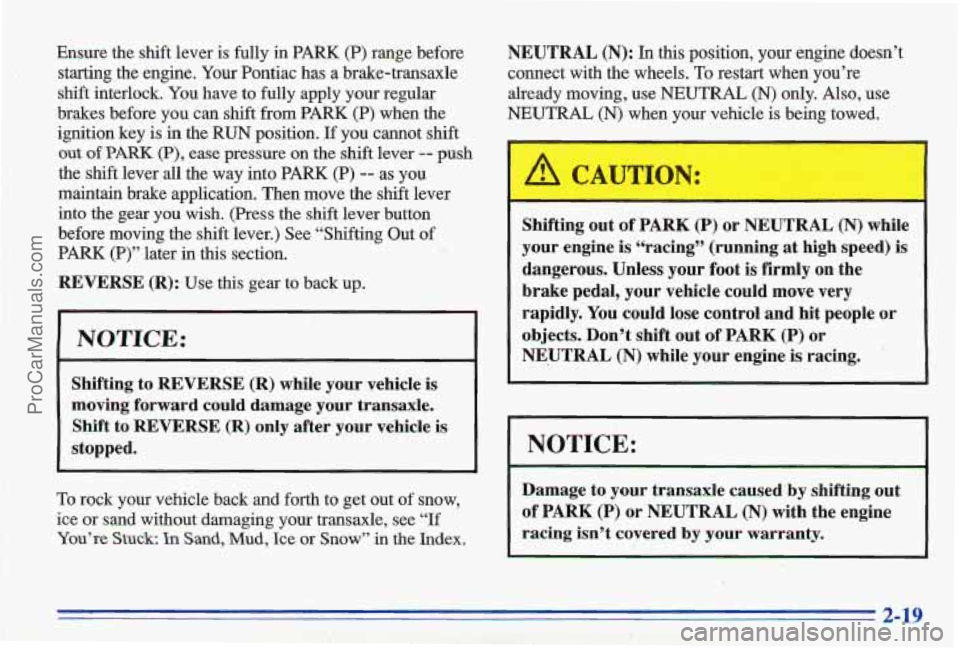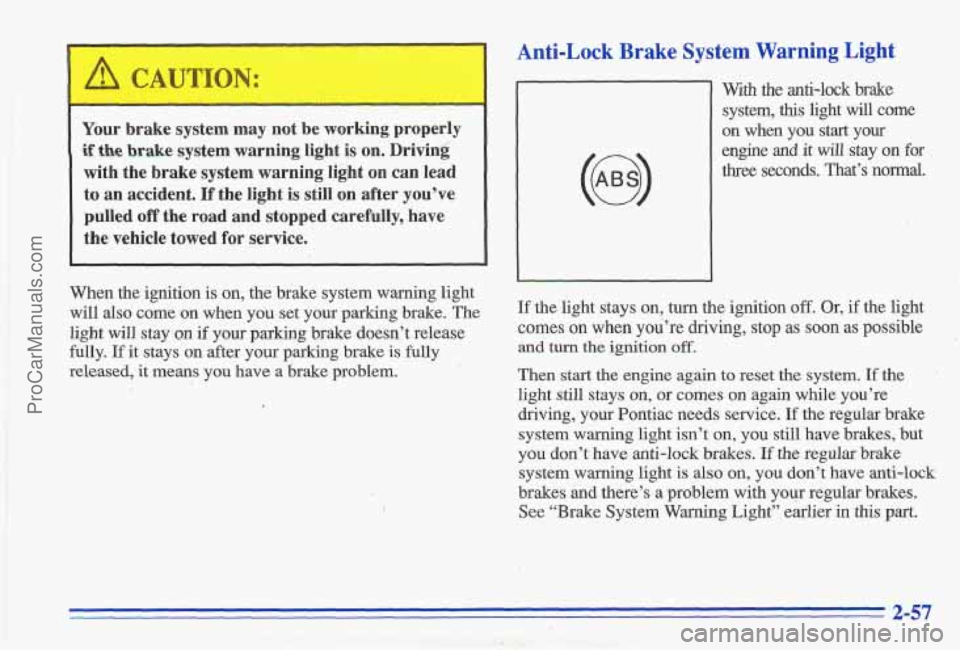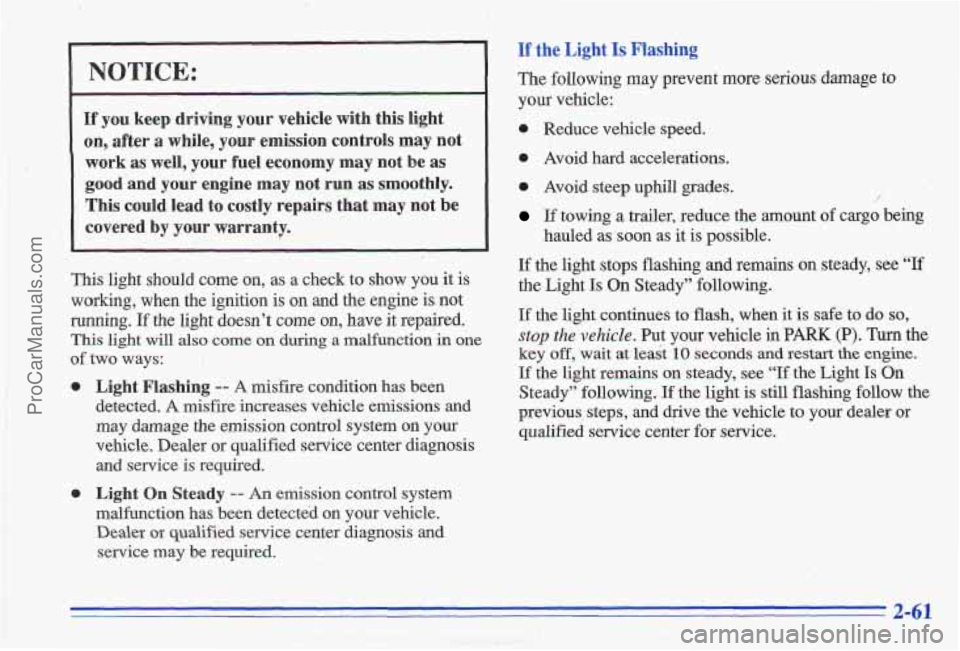stop start PONTIAC GRAND-AM 1996 Owners Manual
[x] Cancel search | Manufacturer: PONTIAC, Model Year: 1996, Model line: GRAND-AM, Model: PONTIAC GRAND-AM 1996Pages: 356, PDF Size: 17.17 MB
Page 66 of 356

If you par^ in a lot where someone will be wawung
your vehicle, it’s best to lock it
up and take your keys.
But what if you have to leave
your ignition key? What if
you have to leave something valuable. in your vehicle?
Put your valuables in a storage area, lie your trunk
Lock the glove box,
Lock all the doors except the driver’s.
or
glove
box,
e Then take the door key with you.
Passlock TM
Your venicle 1s equipped with the Passlock
theft-deterrent system.
Passlock
is a passive theft-deterrent system. The system
,is armed once the key is‘removed from the ignition.
Passlock enables fuel if the ignition lock cylinder is
turned
with a valid key. If a correct key is not used, fuel
is disabled.
During
normal operation, the THEFT SYS light will go
off after the engine is started. In the unlikely event that
the engine stalls and the THEFT SYS light flashes, wait
until the light stops flashing b’efose
trying to restart the
engine. Remember to release the key
from the START
position as soon as the engine starts. If after several tries
the vehicle still does
not start, the vehicle may need
service. At this time, you may
also want to check the
fuses (see “Fuses and Circuit Breakers” in the Index).
See your Pontiac dealer for service.
If the THEFT SYS light comes on while the engine is
running, a problem
has been detected and the system
may need service. See your dealer for service.
In an emergency, call the Bontiac Roadsi4e Assistance
Program at 1-8OO-RBADSIDE or 1-800-762-3743.
ProCarManuals.com
Page 67 of 356

New Vehicle.“Break-In” Ignition
Switch
NOTICE:
Your modern Pontiac doesn’t need an elaborate
“break-in.” But it will perform better in the long
run if you follow these guidelines:
0
0
0 Don’t drive at any one speed -- fast or
slow
-- for the first 500 miles (804 km).
Don’t make.ful1-throttle starts.
Avoid making hard stops
for the first
200 miles (322 km) or so. During this time
your new brake linings aren’t yet broken
in. Hard stops with new linings can mean
premature wear .and earlier replacement.
Follow
this breaking-in guideline every
time you get new brake linings.
Don’t tow
a trailer during break-in. See
“Towing
a Trailer” in the Index for more
information.
C
A E
W
With the key in the ignition switch, you can turn the
switch
to five positions.
ACCESSORY (A): This position lets you use things
like the radio and windshield wipers when the engine is
off. To use ACCESSORY, push in the key and turn it
toward
you. Your steering wheel will stay locked.
..
ProCarManuals.com
Page 69 of 356

Key Release Button (Manual Transaxle)
The key cannot be removed from the ignition unless the
key release button is used.
To remove the key, turn the key to the
OFF position.
While pressing the key release button, tufn the key to
the
LOCK position. Pull the key straight out.
Starting Your Engine
Engines stast differently. The 8th digit of your Vehicle
Identification Number
(VIN) shows the code letter or number for your engine.
You will find
the VIN at the top
left of your instrument panel. (See “Vehicle
Identification Number” in the Index.) Follow the proper
steps to start the engine.
Automatic transaxle
Move your shift lever to PARK (P) or NEUTRAL (N).
Your engine won’t start in any other position
-- that’s a
safety feature. To restart when you’re already moving,
use NEUTRAL
(N) only.
NOTICE:
Don’t try to shift to PARK (P) if your Pontiac is
moving.
If you do, you could damage the
transaxle. Shift to
PARK (P) only when your
vehicle is
stopped.
Manual transaxle
The gear selector should be in NEUTRAL (N). Hold the
clutch pedal to the floor and start the engine. Your
vehicle won’t
stat? if the clutch pedal is not all the way
down
-- that’s a safety feature.
2-13
ProCarManuals.com
Page 70 of 356

Starting Your 2.4 Liter Engine
1. Without pushing the accelerator pedal, turn your
ignition key to
START. When the engine starts, let
go
of the key. The idle speed will go down as your
engine gets
warm.
NOTICE:
H’olding your key in START for longer than
15 seconds at a time will cause your battery to be
drained much sooner. And the excessive heat can
damage your starter motor.
2. If it doesn’t start right away, and if the weather is
very cold (below
-20°F or -29”C), push the
accelerator pedal about one-quarter of the way down
while
you turn the key to START. Do this until the
engine
starts. As soon as it does, let go of the key.
stops), it could be flooded with too much gasoline.
Try pushing your acc,elerator pedal all the way to the
3. If your engine still won’t start (or starts but then floor
and holding it there as you hold the key in
START for about three seconds. This clears the extra
gasoline
from the engine. If the vehcle starts briefly
but then
stops again, do the same thing, but this time
keep the pedal about one-quarter
of the way down
for five or
six seconds.
NOTICE:
Your engine is designed to work with the
electronics in your vehicle.
If you add electrical
parts or accessories,
you could change the way
the engine operates. Before adding electrical
equipment, check with your dealer.
If you don’t,
your engine might not perform properly.
If you ever have to have your vehicle towed, see
the part of this manual that tells how to do it
without damaging
your vehicle. See “Towing
Your Vehicle” in the Index.
2-14
ProCarManuals.com
Page 71 of 356

Starting Your 3.1 Liter Engine
1. Without pushing the accelerator pedal, turn your
ignition key to START. When the engine starts, let
go of the key. The idle speed will go down as your
engine gets warm.
NOTICE:
Holding your key in START for longer than
15 seconds at a time will cause your battery to be
drained much sooner. And the excessive heat can
damage your starter motor.
2. If your engine won’t start (or starts but then stops),
it could be flooded with too much gasoline.
Try
pushing your accelerator pedal all the way to the
floor and holding it there as you hold the key in
START for up to 15 seconds, This clears the extra
gasoline from the engine.
NOTICE:
Your engine is designed to work with the
electronics in your vehicle.
If you add electrical
parts or accessories, you could change the way
the engine operates. Before adding electrical
equipment, check with your dealer.
If you don’t,
your engine might not perform properly.
If you ever have to have your vehicle towed, see
the part of this manual that tells how to do it
without damaging your vehicle. See “Towing
Your Vehicle” in the Index.
ProCarManuals.com
Page 75 of 356

I
Ensure the shift lever is fully in PARK (P) range before
1 ’. I . starting the engine. Your Pontiac has a brake-transaxle !’ 2 . shift interlock. You have to fully apply your regular
brakes before you can shift from PARK (P) when the
ignition key is in the
RUN position. If you cannot shift
out of PARK (P), ease pressure on the shift lever -- push
the shift lever all the way into PARK
(P) -- as you
maintain brake application. Then move the shift lever
into the gear you wish. (Press the shift lever button
before moving the shift lever.) See “Shifting Out
of
PARK (I?)” later in this section.
REVERSE (R):
Use this gear to back up.
NOTICE:
Shifting to REVERSE (R) while your vehicle is
moving forward could damage
your transaxle.
Shift to REVERSE (R) only after your vehicle
is
stopped.
To rock your vehicle back and forth to get out of snow,
ice or sand without damaging your transaxle, see
“If
You’re Stuck: In Sand, Mud, Ice or Snow” in the Index. NEUTRAL
(N):
In this position, your engine doesn’t
connect with the wheels.
To restart when you’re
already moving, use
NEUTRAL (N) only. Also, use
NEUTRAL (N) when your vehicle is being towed.
I
Shifting out of PARK (P) or NEUTRAL (N) while
your engine
is “racing” (running at high speed) is
dangerous. Unless your foot is firmly on. the
brake pedal, your vehicle could move very
rapidly.
You could lose control and hit people or
objects. Don’t shift out of PARK
(P) or
NEUTRAL
(N) while your engine is racing. .
NOTICE:
Damage to your transaxle caused’by shifting ‘out
of PARK
(P) or NEUTRAL (N) with the engine
racing isn’t covered
by your warranty.
ProCarManuals.com
Page 78 of 356

NEUTRAL '(N): Use this position when you start or
idle your engine.
REVERSE (R): To back up, press down the clutch
pedal and shift into REVERSE (R). Let up on the clutch
pedal slowly
while pressing the accelerator pedal.
'1 NOTICE:
Shift to REVERSE (R) only after your vehicle is
stopped. Shifting to REVERSE (It) while your
vehicle is moving could damage your transaxle.
..
1
Also, use WVERSE (R), along with the parking brake,
for parking your vehicle.
Shift Speeds
I A CAUTION:
If you skip more than one gear when you
downshift, you could lose control of your vehicle.
And you could injure yourself or others. DonY
shift from
FIFTH (5) to SECOND (2) or from
FOURTH (4) to FIRST (1).
This chart shows when to shift to the next higher gear
for best
fuel economy.
ProCarManuals.com
Page 113 of 356

Your brake system may not be working properly
if the brake system warning light is on. Driving
with the brake system warning lighlt on can lead
to an accident.
If the light is still on after you’ve
pulled off the road and stopped carefully, have
the vehicle towed
for service.
When the ignition is on, the brake system warning light
will also come
on when you set your parking brake. The
light will stay on if your parlung brake doesn’t release
fully.
If it stays on after your parking brake is fully
released,
it means you have a brake problem.
Anti-Lock Brake System Warning Light
With the anti-lock brake
system,
this light will come
on when you
start your
engine
and it will stay on for
three seconds. That’s normal.
If the light stays on, turn the ignition off. Or, if the light
comes on when you’re driving, stop
as soon as possible
and turn the ignition off. &. 1
Then start the engine again to reset the system. If the .I ‘I
light still stays on, or comes on again while you’re
driving, your Pontiac needs service.
If the regular brake
system warning light isn’t
on, you still have brakes, but
you don’t have anti-lock brakes.
If the regular brake
system warning light is also on, you don’t have anti-lock
brakes and there’s a problem with your regular brakes. See “Brake System Warning Light” earlier
in .this part.
2-57
ProCarManuals.com
Page 117 of 356

I NOTICE:
If you keep driving your vehicle with this light
on, after a while, your emission controls may nmot
work as well, your fuel economy may not be as
good and your engine may not run as smoothly.
This could lead to costly repairs that may not be
covered by your warranty.
This light should come on, as a check to show you it is
working, when the ignition
is on and the engine is not
running.
If the light doesn’t come on, have it repaired.
This
light will also come on during a malfunction’ in one
of two ways:
0 Light Flashing -- A misfire condition has been
detected.
A misfire increases vehicle emissions and
may damage the emission control system on your
vehicle. Dealer or qualified service center diagnosis
and service is required.
0 Light On Steady -- An emission control system
malfunction has been detected on your vehicle.
Dealer or qualified service center diagnosis and
service may be required.
If the Light Is Flashing
The following may prevent ml
your vehicle:
0 Reduce vehicle speed.
0 Avoid hard accelerations.
0 Avoid steep uphill grades.
e serious damage to
i
If towing a trailer, reduce the amount of cargo being
hauled as-soon as it is possible.
If the light stops flashing and remains on steady, see “If
the Light Is On Steady” following.
If the light continues to flash, when it is safe to do so,
stop the vehicle. Put your vehicle in PARK (P). Turn the
key off, wait at least 10 seconds and restart the engine.
If the light remains on steady, see “If the Light Is On
Steady” following.
If the light is still flashing follow the
previous, steps, and drive the vehicle to
your dealer or
qualified service center for service.
2-61
ProCarManuals.com
Page 119 of 356

Oil Pressure Light
..
If you have a problem with your oil, this light may stay
on after you start your
engine,
or come on when
you are driving. This
indicates that oil is not
going through your engine
quickly enough to keep it
lubricated.
The engine could be low
on oil, or could have some
other oil problem. Have it fixed right away.
The oil light could also come on in the following
situations:
When the ignition is on but the engine is not running,
the light will come on as a test to show you it is
working, but the light will go out when you turn the
ignition to START. If it doesn’t come on with the
ignition
on, you may have a problem with the fuse or
bulb. Have it fixed right away.
0 On four cylinder engines, when the engine is idling
at
a stop, the light may blink on and off. In addition,
if you make a hard stop, the light may come on for a
moment. This is normal.
Don’t keep driving if the oil pressure is low.
If
you do, your engine can become so hot that it
catches fire. You or others could be burned.
Check your oil
as soon as possible and have
your vehicle serviced.
I NOTICE:
Damage to your engine from neglected oil
problems can be costly and
is not covered by your
warranty,
2-63
ProCarManuals.com